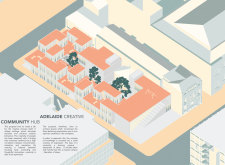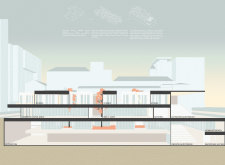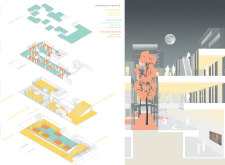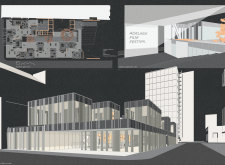5 key facts about this project
The design emphasizes a layout that is both functional and engaging, seamlessly integrating various spaces to minimize boundaries between different modes of interaction. Each area of the hub serves a distinct purpose yet contributes to a cohesive atmosphere. The layout includes dedicated studios for creative work, common areas for relaxation and social connection, and outdoor venues that enhance engagement with the surrounding environment. This carefully orchestrated organization encourages individuals to move fluidly through the space, facilitating spontaneous encounters and collaboration.
One notable feature of the project is its vertical design. The utilization of multiple floors creates a dynamic interplay between spaces, allowing for natural light to flood interiors and providing inhabitants with a connection to the outdoors. Each level is intentionally designed to cater to different activities, ranging from quiet, focused workspaces on one floor to more vibrant, open collaboration areas on another. This vertical segmentation balances the need for privacy and protection while also welcoming community interaction.
A critical aspect of the project is its integration with outdoor spaces. The design incorporates green areas that serve as both gathering spots and inspiration zones. Outdoor auditoriums and community lawns are positioned strategically, encouraging residents to enjoy their surroundings while engaging in various events and programs. This natural connection is a vital part of the concept, as it promotes well-being and creativity by allowing individuals to step outside and immerse themselves in a calming landscape.
Materiality plays a significant role in the project's architecture. A selection of materials has been chosen not only for aesthetic appeal but also for their functionality. Concrete serves as the backbone of the structure, offering robustness and durability, while glass facades invite transparency and light into the interior spaces. Steel elements provide structural support, particularly in balconies and outdoor areas, enhancing the facility's modern aesthetic. The warm, natural tones of wood are used extensively in studio spaces and communal areas, fostering an inviting atmosphere. Brickwork adds texture and depth to the facade, creating a rhythmic interplay with the surrounding environment. Coupled with the thoughtfully landscaped areas, these materials work together to create a harmonious blend of form and function.
The unique approaches incorporated in the project underscore its aim to support a diverse range of activities, making it a workspace that evolves with its users. The design intentionally blurs the traditional boundaries between various functions, fostering a sense of community and inclusivity. The resulting architecture promotes an environment where creativity can flourish in multiple forms, reflecting the essence of collaboration and shared experiences.
This focus on community engagement is paramount to the overall vision of the Adelaide Creative Community Hub. The combination of distinct yet interconnected spaces encourages local residents to take ownership of their environment, transforming the hub into a vibrant beacon for creativity. It serves as an educational facility, a social gathering place, and an artistic haven, encapsulating the diverse aspects of cultural exchange.
To delve deeper into the architectural plans, sections, designs, and ideas that shape this project, readers are encouraged to explore the project presentation for a complete understanding of its innovative approach and functional aspirations. Discover how this project can redefine the way communities interact and collaborate through thoughtfully designed architectural spaces.


























